Hydrangea Annabelle - Planting, Care and Reproduction Guide
Even a single hydrangea can transform an unsightly area, giving it a Japanese flavor or European sophistication. Snow balls, the flower of the snow hills, the snow queen - these are all the folk names of the most common tree hydrangea Annabelle. For the first time her wild ancestor was discovered by a resident of Illinois near the town of Anna, hence the name of the flower - beautiful Anna.
- general characteristics
- External description
- Varieties of varieties
- Landing features
- Timing
- Seat selection
- Preparation of planting material
- Technology
- How to care for
- Watering
- Top dressing
- Pruning
- Loosening and mulching
- Preparing for winter
- Reproduction
- Cuttings
- Layers
- Dividing the bush
- Diseases and pests
- Terms of use in the landscape
- Variety reviews
- Useful videos
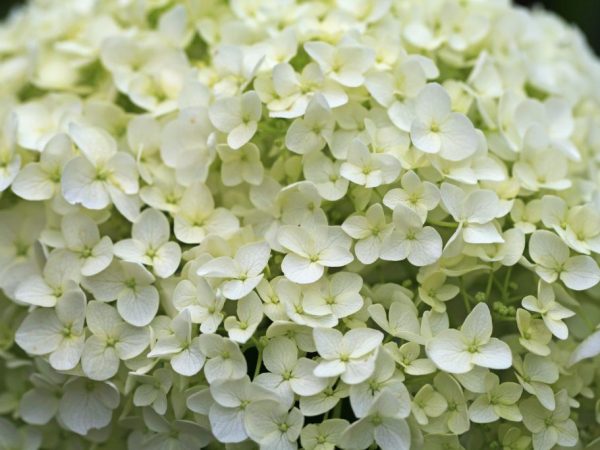
Hydrangea white tree annabelle
general characteristics
Annabelle arborescens Hydrangea is the Latin name of this beauty. She is a real hit, the pinnacle of the tree hydrangea line. She was awarded the Garden Merit (AGM) of the British Royal Horticultural Society for its high decorative qualities.
It is found naturally in moist soils under canopy of hardwoods, on stream banks, and on the outskirts of forest roads along the entire east coast of the United States. Now her recognizable silhouette can be found in almost every garden.
Excavations in Alaska have shown that hydrangea grew in the northern regions of America 40-70 thousand years ago.
External description
Huge caps-shields up to 15-25 cm in diameter, densely covered with sterile three-petal flowers, formed in June. Their color at this stage is light jade, turning into snow-white in July-August. In autumn, green strokes appear again, and by winter the inflorescences acquire the color of noble bronze.
The dark green foliage effectively sets off the white caps and does not change shade under the sun. Large (8-18 cm long), beautifully embossed leaves are ovoid with a jagged edge. Their lower surface is naked or with hardly noticeable hairs.
The leaf blades sit oppositely on stems 0.9-1.5 m high. Under the weight of the huge caps, the shoots gracefully bend, giving the bush an extraordinary charm.
The bark of the branches has the peculiarity of exfoliating into several successive thin layers of different colors, forming "seven clothes".
Hydrangea root was used medicinally by the Indians and later by early settlers to treat kidney and bladder stones.
Varieties of varieties
Until 2010, the tree hydrangea was represented only by white flowers.
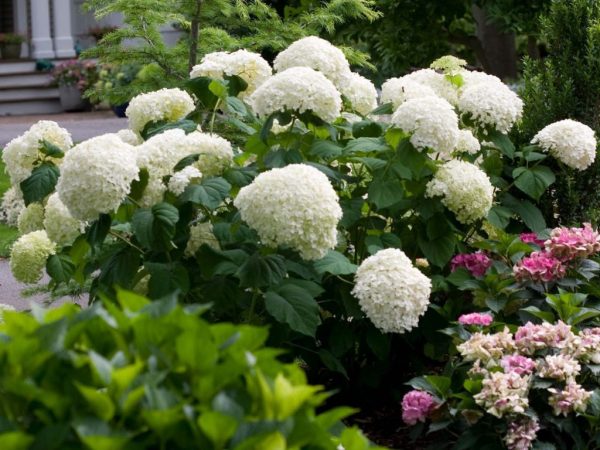
Hydrangea tree annabelle
In the last decade, breeders have created 2 varieties with colored sterile flowers and strong short (up to 90 cm tall) stems that can support the weight of huge flower caps without bending in the rain. Compact bushes retain their shape throughout the season, regardless of weather conditions.
New cultivars have improved decorative properties:
- Ruby Annabel with dark red buds and large sterile flowers, the shade of which varies from wine-burgundy to silvery pink.The variety received a bronze medal at the international exhibition of ornamental plants Plantarium-2016 in the Dutch city of Boskop;
- Pink Annabelle (Pink Annabelle) - with rich pink rounded flat inflorescences, by autumn acquire an elegant color of "dusty rose".
Hydrangea Strong (Strong) - one of the varieties of the classic Annabelle, created recently. She inherited the virtues and lacks the flaws of the progenitor:
- the height is the same;
- blooms on the shoots of the current year, longer;
- inflorescences in size and quantity are larger. They cover the shrub with a continuous flowering carpet;
- stems are strong, do not bend to the ground under the weight of massive heads;
- tolerates frosts down to -40 ° С.
All varieties bloom every year, even after heavy pruning and low winter temperatures.
Landing features
Annabelle arb. Hydrangea belongs to unpretentious crops. It can survive in conditions in which less hardy plants weaken and die. But the rules for planting and leaving are still better to follow.
Timing
The optimal timing for planting in the ground depends on the method of growing the seedling:
- a closed-root shoot (SCS) takes root well at any time of the year at a positive average daily air temperature;
- a plant with an open root system (ACS) is planted in April, when the earth warms up, but has not yet lost much moisture. And also in the fall, a month before stable frosts, so that the roots can gain a foothold in the soil. If the seedlings are planted too late, they must be mulched with a thick layer of sawdust or peat to protect them from the cold.
When planting in summer, the main danger is a lack of water and its rapid evaporation through wide leaves.
The botanical name for the shrub is Hydrangea. Translated from Greek, it means "a vessel with water" and speaks of an important quality of the plant - increased hygrophilia.
In hot weather, planting must be shaded for at least 7-10 days, watered abundantly and sprayed.
Seat selection
Hydrangeas love the sun, but do not tolerate direct midday rays. The best place for them is a space closed from drafts, where the sun looks in the morning (until 12 noon) and evening (after 4 pm).
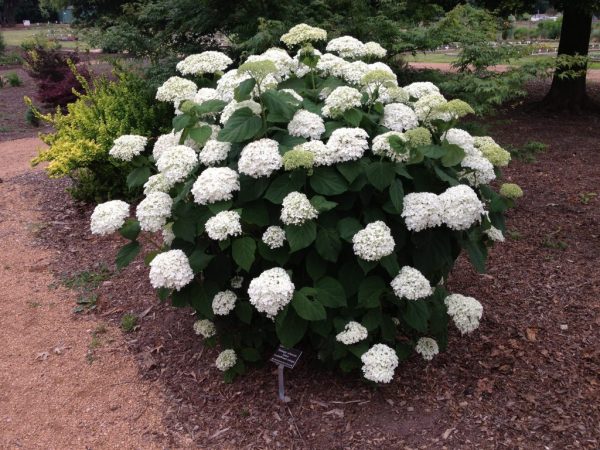
Anabelle hydrangea
Full shade, like full sun, negatively affects decorative qualities:
- in the sunshine, its flowers and leaves shrink;
- with a lack of light (less than 6 hours a day), the stems are stretched, the saturation of the tone of the leaves decreases, and the buds may not form.
Hydrangeas cannot withstand competition for moisture and nutrition with fruit trees, so they are planted at a great distance from each other.
The site for planting is chosen by:
- without a close approach of soil water, but with soil capable of retaining moisture;
- with a slightly acidic reaction;
- breathable.
Loam fertilized with compost and peat will do. Hydrangea will take out even sandy loam soil, only the amount of watering in this case must be increased.
Before planting, the site is dug up, weed roots are removed, organic fertilizer is applied.
Then the places for planting holes are marked - taking into account the rapid growth of the culture, the minimum distance to neighbors should be at least 1.5 m.
Important! Adult hydrangeas do not tolerate transplanting well. Annabelle has been growing in one place for 40-50 years.
Preparation of planting material
For planting, seedlings of 2-3 years old with a developed root system and strong shoots are chosen. The health of the plant can be determined by the turgor of the leaves, the absence of cobwebs, larvae and egg clutches on them.
The soil in the container should not have salt deposits or mold, and the flower itself should not have a rotten smell.
After purchasing, the hydrangea must be prepared for planting. To do this, the seedling:
- treated with antistress drugs: succinic acid (2 tablets per 1 liter), HB-101 (1 drop per 1 liter);
- the container is soaked and kept in water until all the air is released;
- the roots of a seedling with ACS are cut by 3-4 cm, immersed in a solution with a root for 2-3 hours.
Hydrangea is considered a plant for people born from April 11 to April 20. Astrologers advise them to plant it in their garden.
Technology
The planting pit is prepared 2-3 times larger than the earthen clod of the seedling, usually 50x50 and up to 70 cm deep. A 10-15 cm drainage layer is poured onto the bottom of the pit: expanded clay, broken brick, river pebbles. No matter how moisture-loving hydrangea is, the constant moisture of the roots can provoke a fungal disease.
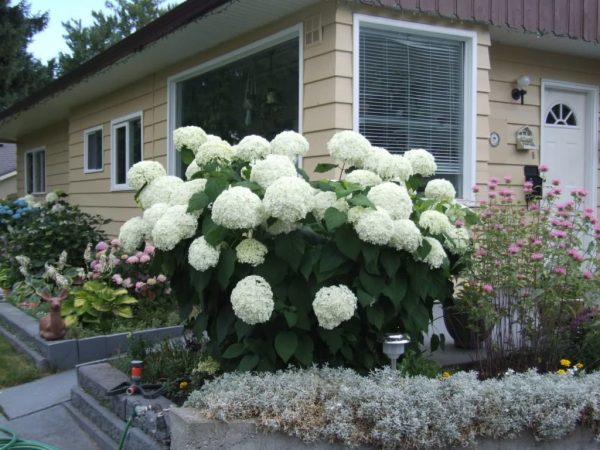
Annabelle hydrangea tree
Next, the substrate is formed in equal proportions:
- garden land;
- peat;
- compost.
Add 1 glass of superphosphate, 1 tbsp. l. potassium sulfate, if available - 1 tbsp. ammonium sulfate.
Important! Fresh manure is not placed in the pit - it can burn the roots.
Then the following operations are carried out:
- the drainage is covered with a 5 cm layer of soil;
- spilled with water with the addition of 2-3 crystals of potassium permanganate to destroy pathogenic microflora;
- a seedling is installed in the pit;
- fill up the remaining soil so that the root collar is flush with the ground.
- tamped so that there are no air voids in the pit;
- watered abundantly.
In order for the flower to take root faster, the buds and inflorescences are cut off - so its forces will be directed to the formation of new suction roots.
In Japan, hydrangeas are a sign of gratitude - they were given by ancient emperors to their beloved. In Europe, the Victorians believed that these plants symbolized boast or vanity, because they have many flowers, but very few seeds.
How to care for
Annabelle is called "forgiving" hydrangea - she will forgive many mistakes of the owner. But it will fully show its beauty with proper care.
Watering
Watering Annabelle arborescens Hydrangea is necessary with soft water (rain or settled tap water) so that the ground is moist, but not wet. The topsoil should dry out 1-2 cm between waterings.
Florists of an arboretum in Illinois add hydrogel granules to the near-stem circle of hydrangeas. They are buried to a depth of 3-10 cm around the roots to maintain a constant level of moisture required by the plant.
There are 4 stages of water scarcity:
- In summer, the flowers turn green.
- The leaves wilt but do not fall off.
- Leaves fall.
- Flowers are falling.
If the plant is in 2 or more stages, it is "cast" gradually - most of all, shock doses of water damage hydrangeas after a long drought. Florists recommend in this case to apply drip irrigation with ambient temperature.
To maintain the soil in a wet state, mulching of the trunk circle is used.
3-4 times a season Annabelle is watered with slightly acidified water - 1 tsp. vinegar or citric acid solution in 3 liters of water to prevent chlorosis.
Top dressing
Hydrangea is a profusely flowering deciduous shrub. For the formation of green mass, he needs a large dose of nitrogen at the beginning of the growing season, a lot of phosphorus during the budding period and potassium in preparation for winter.
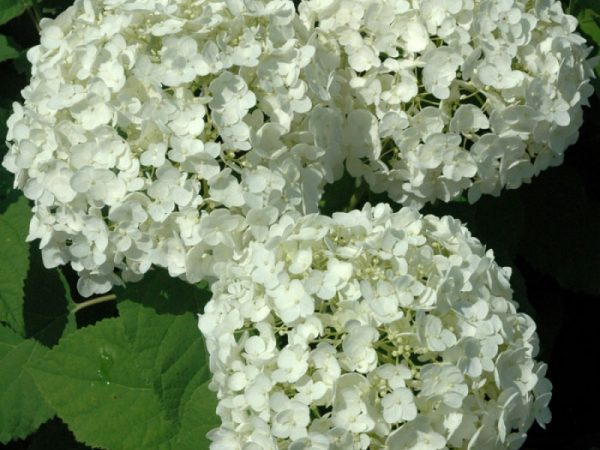
Hydrangea anabel photo description
Based on this, the feeding scheme is as follows:
- March-April - full complex fertilizer with an increased concentration of nitrogen or a mixture of potassium sulfate and urea - 1 tbsp. spoon 10 liters;
- end of May-June - superphosphate with the addition of a small amount of urea in a ratio of 2: 1, natural organic matter - nettle infusion, slurry;
- August-September - potassium magnesium or potassium sulfate, superphosphate - 1 tbsp. l per bucket of water.
If, during planting, mineral fats were introduced into the planting pit, no fertilizing is carried out in the first 2 years.
This flower needs a sufficient amount of iron, mainly in a chelated (easily assimilated) form. If there is a lack of this substance in the soil, chlorosis will hit the bushes. Therefore, at least once a season, you need to give fertilizers specially created for hydrangeas.
Important! For the plant to assimilate iron, the soil must be slightly acidic.
Pruning
Anabelle forms a beautiful shape and large inflorescences only with regular haircuts.Pruning is carried out both in autumn, before snowfalls, and in spring.
In winter, a tree hydrangea can be pruned "on a stump" - it will still bloom the next year, because buds are formed on the shoots of the current year. But in order for the bushes to be of solid size, pruning is carried out to a height of 50-60 cm.
Cut flush with the ground:
- curves, thin stems;
- shoots growing inside the bush;
- shoots over 3 years old.
If the branches are left to their full length, cutting off only the inflorescences, the hydrangea will bloom, but it will no longer be able to form large caps.
Note! The size of the flower head is related to pruning. When aggressive, the shoots will be more energetic, the inflorescences will be more massive, but their number is less. Gentle pruning will result in fewer but more hats.
In the spring, before the start of sap flow, pruning is also possible. At this time, damaged or frozen shoots are removed to the first pair of healthy buds.
If in the spring months they did not have time to cut the bush, the next suitable period for her is after the leaves bloom.
Take note! The weaker the shoot of the current year, the shorter it should be cut.
Loosening and mulching
To retain moisture in the soil, the best operations are loosening and mulching the trunk circle, as well as removing weeds. It must be remembered that the roots of the hydrangea are located close to the surface, so the loosening should be no deeper than 5-7 cm.
Loosens the soil after watering to reduce capillary evaporation and ensure air permeability to the root system.
The most suitable materials for mulching are those that can increase the acidity of the soil:
- sawdust;
- peat;
- coniferous litter.
Proponents of bio-farming in the University Garden of Georgia call for mulching the land around the hydrangeas with fruit litter - apples, pears - this way the acid balance of the soil is maintained and the number of earthworms increases. At the same time, they are warned against using cut grass as mulch: when it dries, it reduces the acidity of the soil.
The positive effect of adding organic matter is confirmed by the experiments of our biologists.
Preparing for winter
Treelike hydrangeas are less resistant to cold than paniculate hydrangeas, but they withstand frosts well down to -25C. Even if the bush freezes out, but its roots do not suffer, the plant will hatch and bloom next year, because Annabelle forms flower buds on the shoots of the current year.

Anabelle hydrangea photo
Therefore, when preparing for winter, the main thing is to ensure the safety of the root system. To do this, after the autumn pruning, the trunk circle is covered with peat, humus, compost. Cover with spruce branches from above.
Reproduction
Treelike hydrangea propagates by cuttings, layering and dividing the bush.
Cuttings
For this operation, ripe shoots of the current or last year without signs of disease and pests are suitable. The stem is cut into a stalk at the time of flowering, at this time it contains the greatest amount of active substances.
Then proceed as follows:
- the green top is removed;
- the stem is cut into several parts, each of which has 3-4 pairs of leaves, while the lower cut is made at an angle;
- the lower leaves are torn off so as not to damage the growth buds in their sinuses, the rest are shortened by half;
- the cuttings are soaked in a root-forming solution for 2-3 hours in a dark place;
- stuck into a wet substrate consisting of sand and peat in a 1: 2 ratio, deepening to the second pair of leaves;
- cover with a plastic bottle on top.
The soil in such a mini-greenhouse should be constantly moistened, but not wet! The greenhouse is ventilated weekly.
Roots begin to form at 4-5 weeks from the lower growth buds. As soon as new shoots appear from the axils of the upper leaves, the seedlings are planted in a greenhouse or greenhouse for acclimatization. For the winter, they are insulated with spruce branches and spunbond. If severe frosts are expected, then it is better to leave for the winter in a cellar, where the temperature is not higher than 3-4 C.
Layers
Annabelle easily forms additional shoots from lodged or specially bent stems. To do this, one of the branches of 1-2 years old must be laid in a radial groove, pinned in the middle with slingshots and sprinkled with earth. This operation is carried out in early spring, before the leaves bloom. By October, new stems 40-50 cm tall will grow from the axillary buds. They are separated from the uterine branch and planted in a growing bed. For the winter, young seedlings must be covered.
Dividing the bush
This operation is carried out with digging out a bush (when transplanting, for example) or digging in.
In any case, the entire root ball or part of it is freed from the ground, carefully cut into sections so that each has several buds and ripe roots. The separated part of the plant is immediately planted in a new place.
Diseases and pests
The main causes of diseases of hardy hydrangea are:
- high air temperature with a lack of moisture - spider mites are activated;
- thickening of plantings, increased soil moisture - fungal diseases occur;
- untimely and unbalanced fertilizers, especially nitrogen fertilizers after flowering.
Viral diseases are manifested by "patterns" and deformation of the leaves. The main vectors are insects - aphids and ants.
- For fungal diseases (powdery mildew, gray rot), fungicides should be used.
- In case of an invasion of pests - insecticides.
- If you suspect a viral infection, only the removal of the affected part of the plant will help. This is the only way to save the remaining samples from infection.
Terms of use in the landscape
Hydrangea in landscape design is used more often than other colors. Solitaire, mass plantings, screens, hedges, a plant of the second plan - everywhere it is advantageous and effective.
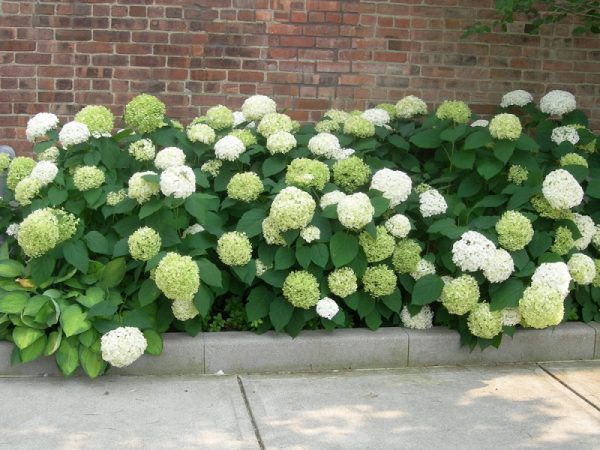
Hydrangea tree anabel planting and care photo
In the first years of her life, Annabelle is not very decorative; she resembles an ankle-headed teenager with thin twigs-legs. Therefore, flowering annuals 15-20 cm high, with a shallow root system, are planted around it.
In the future, when the bush grows to its planned size, perennials can be planted near the hydrangea, which require the same growing conditions:
- hosts;
- conifers;
- azaleas;
- heather.
And yet - Annabelle is good at pots! It will decorate the balcony / terrace with abundant flowering, full of charm, and add volume to compositions of annual plants, often miniature. Her massive hats look especially impressive in tall narrow containers.
In 1930, gardener and poet Twisted Sackville West in Sissinghurst, England designed a white garden based on white hydrangeas. Until now, this project is considered the standard of elegance, purity of sophistication ...
In France, the popular neighborhood is Annabelle arb. Hydrangea with boxwood and Japanese maple.
Variety reviews
In the stories about Annabelle, her owners use only superlatives - her snow-white hats against the background of dark patterned foliage are so good. Designers highly appreciate the plasticity of the flower - it organically fits into any style - from oriental with its clear graphics to French with refined simplicity and elegance.
Some novice growers are dissatisfied with the long period of greening of Annabelle's inflorescences. But this is often caused by inaccuracies in care.
Many gardeners living in areas with a harsh climate note the resistance of hydrangeas to frost and almost complete recovery after freezing.
Needlewomen like dry bouquets of Anabel, which do not lose their shape and color for a long time.
Whether this is your first or fifth garden, you will never regret using Annabelle Hydrangea in your flower garden. With huge snow-white flowers, lush foliage and a forgiving nature, she will be your best friend.


